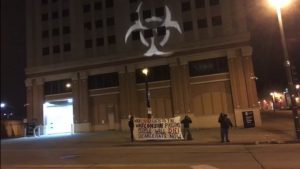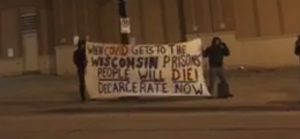The following report was sent to us from Forum for Understanding Prisons, check out their site here and keep up with the effects COVID 19 is having on our most vulnerable population—prisoners.

On Friday March 20th, a small gathering outside of the dungeon in downtown Milwaukee took place. There are more than 23,000 people incarcerated in Wisconsin. Because the WI DOC prisons operates at about 130% of capacity, the virus will spread fast. There are at least 1,100 prisoners that are at risk (either elderly or immune compromised), and the DOC is doing nothing to protect them. Captive populations are at the mercy of the state, and the state is not responding responsibly.
Here is an interview with one of the organizers of this event: Interview with Forum for Understanding Prisons.

Banner reads:
When COVID Gets To The
Wisconsin Prisons
People Will Die!
Decarcerate Now

Bio-hazard symbol projected onto Milwaukee’s downtown prison MSDF.
Video of the demonstration: FFUP Live Outside MSDF.
The following demands are from a recent report produced by Forum for Understanding Prisons. You can find the full report here: Wisconsin Death Trap: How Prison Jeopardizes Public Safety in Times of Pandemic.
The Governor must direct DOC Secretary Carr, his staff, and Parole Commission Chair John Tate II to take dramatic emergency action now, before a COVID-19 outbreak, to mitigate its potentially devastating impact on Wisconsin’s already unstable facilities.
First: Release as many people as possible to reduce dangerous overcrowding.
- Grant compassionate release to all elderly and immune-compromised people from Wisconsin prisons. The death penalty is not legal in Wisconsin but by continuing to incarcerate vulnerable people while a deadly virus spreads through the system Governor Evers will be effectively sentencing people to death.
- End crimeless revocations and release those held on them. Nearly half of new admissions into Wisconsin’s overcrowded prisons come not from new criminal convictions, but “rules only” violations. Eliminating this practice and releasing everyone currently doing time on a revocation is the single best way to reduce overcrowding and prevent the spread of COVID-19 though Wisconsin prisons. Also, endangering or shortening someone’s life because they violated a technical rule of supervision is grotesque.
- Release all parole-eligible people with re-entry plans or on less than 12 month defers. The parole commission under John Tate has been gradually increasing the rate of releases from a virtual standstill under the previous chair, Daniel Gabler. Many of the 2800 parole-eligible “old law” prisoners are at the lowest security levels, with release plans at the ready. Tate could expedite the release of these people so they can self-quarantine with family and not exacerbate the overcrowding and risk of COVID-19 outbreak in their prisons.
- Issue a mass clemency or emergency furlows for low-level offenders and people nearing release. Last year Governor Evers reinstated the pardon board to much fanfare, but zero actual releases. He limited criteria to people convicted of certain crimes who had finished serving their full sentence, including supervision more than 5 years ago. Meanwhile, the Republican Governor of Oklahoma recently released hundreds of people in a single day.
Minimum security facilities are among the most overcrowded, and hundreds of people on work release in these facilities have been getting out daily to work in the community already. Releasing these people is surely a lower risk to public safety than forcing them to crowd prisons, turning them into incubators for disease.Second: Give incarcerated people the means to protect themselves.
- Prioritize testing in prisons and distribute CDC prevention guidelines. Testing materials are limited nation-wide, and traditionally incarcerated people are the last to receive care when it becomes scarce, even if they are most at risk. This tradition cannot continue in today’s exceptional circumstances. Prisons are incubators for the disease, they will help it spread across the state. Monitoring these sites closely is necessary to slow that spread.
- Distribute soap, tissues, gloves, masks, gauze to filter vents, and disinfectant wipes or sprays. Handwashing is the most effective way to stop the spread of COVID-19, but Wisconsin DOC provides some indigent people with barely enough soap to wash their hands once daily. Tissues and toilet paper are strictly rationed. Masks, alcohol gel or wipes are completely forbidden. All these things must be distributed free of charge immediately.
- Stop stealing money through Act 355. Wisconsin DOC is empowered to determine the percentage they take. The new administration continues Governor Walker’s practice of taking 50% or more. Secretary Carr must reduce this amount so people can buy needs with support of their loved ones.
- Make phone, email and tablet access free. The people who remain incarcerated need every opportunity to connect with their loved ones during this crisis.
- Support re-entry for people being released. Governor Evers needs to expand housing and social services in light of the pandemic already. These services should be made available for the emergency prisons releases we’re demanding.
Third: Drive sadistic racists and staff who dehumanize and endanger people out of the DOC.
- Fire Warden Susan Novak and other problem staff. Novak’s track record of medical neglect speaks for itself. Her regime of sadism and racially targeted abuse cost lives when there wasn’t a deadly pandemic going on.
- Create an environment that supports nurses and care workers. The DOC has a demonstrated inability to treat its captives as human beings deserving of care. The Department of Health Services should take over care-giving operations in the prisons. DOC staff should defer to medical and mental health professionals.
- Mandate emergency de-escalation and anti-racist training. The DOC staff is currently unprepared to manage the heightened tension of an effective COVID-19 containment plan.